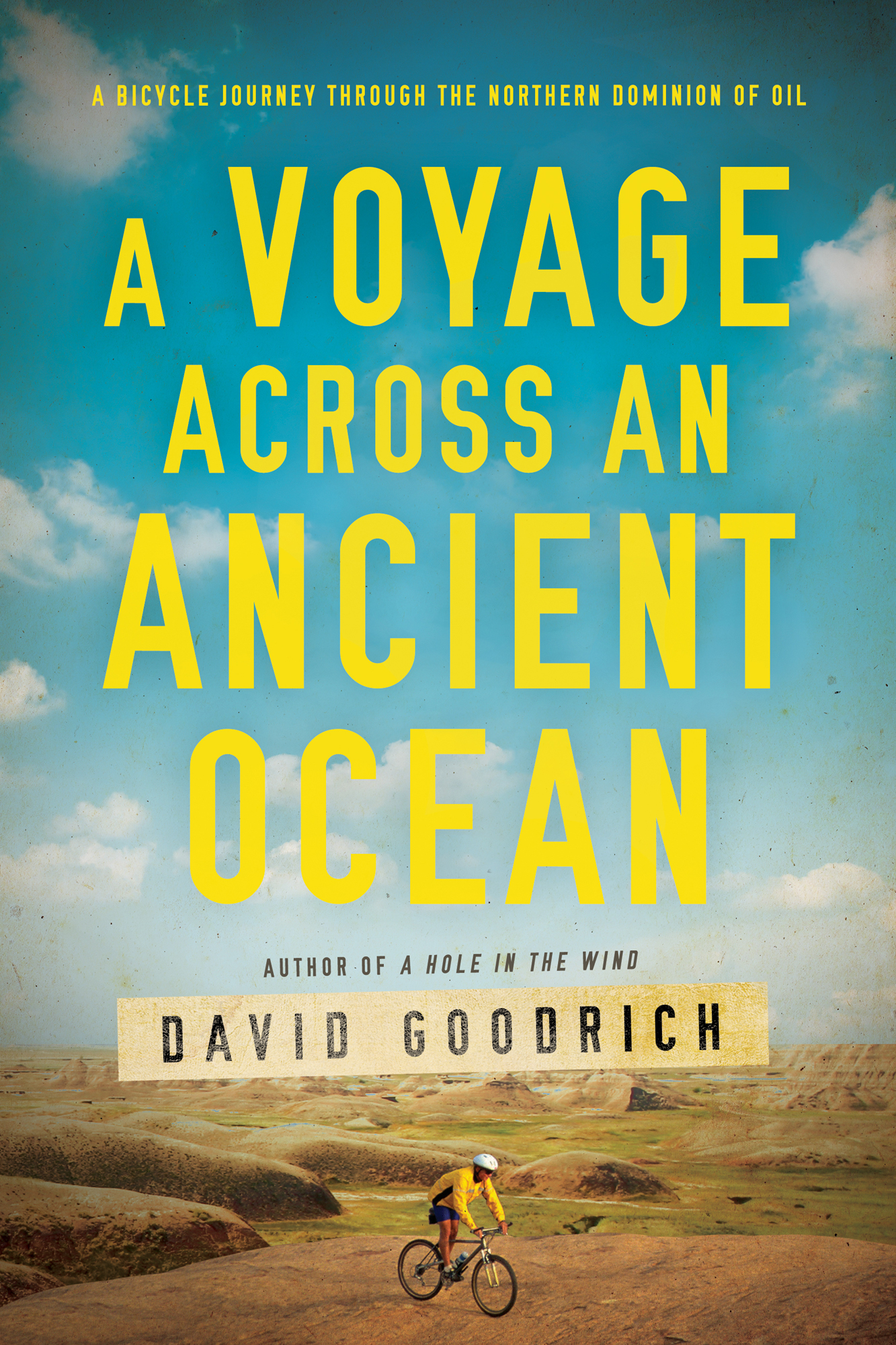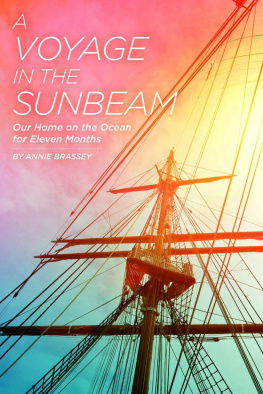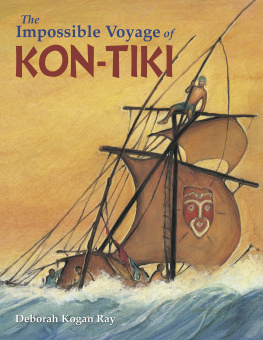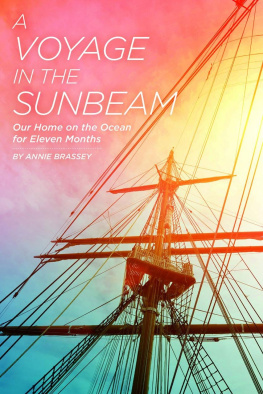David Goodrich - A Voyage Across an Ancient Ocean: A Bicycle Journey Through the Northern Dominion of Oil
Here you can read online David Goodrich - A Voyage Across an Ancient Ocean: A Bicycle Journey Through the Northern Dominion of Oil full text of the book (entire story) in english for free. Download pdf and epub, get meaning, cover and reviews about this ebook. year: 2020, publisher: Pegasus Books, genre: Detective and thriller. Description of the work, (preface) as well as reviews are available. Best literature library LitArk.com created for fans of good reading and offers a wide selection of genres:
Romance novel
Science fiction
Adventure
Detective
Science
History
Home and family
Prose
Art
Politics
Computer
Non-fiction
Religion
Business
Children
Humor
Choose a favorite category and find really read worthwhile books. Enjoy immersion in the world of imagination, feel the emotions of the characters or learn something new for yourself, make an fascinating discovery.

- Book:A Voyage Across an Ancient Ocean: A Bicycle Journey Through the Northern Dominion of Oil
- Author:
- Publisher:Pegasus Books
- Genre:
- Year:2020
- Rating:5 / 5
- Favourites:Add to favourites
- Your mark:
- 100
- 1
- 2
- 3
- 4
- 5
A Voyage Across an Ancient Ocean: A Bicycle Journey Through the Northern Dominion of Oil: summary, description and annotation
We offer to read an annotation, description, summary or preface (depends on what the author of the book "A Voyage Across an Ancient Ocean: A Bicycle Journey Through the Northern Dominion of Oil" wrote himself). If you haven't found the necessary information about the book — write in the comments, we will try to find it.
David Goodrich: author's other books
Who wrote A Voyage Across an Ancient Ocean: A Bicycle Journey Through the Northern Dominion of Oil? Find out the surname, the name of the author of the book and a list of all author's works by series.
A Voyage Across an Ancient Ocean: A Bicycle Journey Through the Northern Dominion of Oil — read online for free the complete book (whole text) full work
Below is the text of the book, divided by pages. System saving the place of the last page read, allows you to conveniently read the book "A Voyage Across an Ancient Ocean: A Bicycle Journey Through the Northern Dominion of Oil" online for free, without having to search again every time where you left off. Put a bookmark, and you can go to the page where you finished reading at any time.
Font size:
Interval:
Bookmark:


ALSO BY DAVID GOODRICH
A Hole in the Wind
VOYAGE ACROSS AN ANCIENT OCEAN
Pegasus Books Ltd.
148 W 37th Street, 13th Floor
New York, NY 10018
Copyright 2020 by David Goodrich
First Pegasus Books edition August 2020
Interior design by Maria Fernandez
Interior maps by Lara Andrea Taber
Cover design by Faceout Studio, Lindy Martin
Cover art from Getty, Shutterstock, Stocksy
All rights reserved. No part of this book may be reproduced in whole or in part without written permission from the publisher, except by reviewers who may quote brief excerpts in connection with a review in a newspaper, magazine, or electronic publication; nor may any part of this book be reproduced, stored in a retrieval system, or transmitted in any form or by any means electronic, mechanical, photocopying, recording, or other, without written permission from the publisher.
Library of Congress Cataloging-in-Publication Data is available.
ISBN: 978-1-64313-446-8
Ebook ISBN: 978-1-64313-447-5
Distributed by Simon & Schuster
www.pegasusbooks.us
For Concetta, who is always at the end of my roads


T here was something dreamlike about it. For a week in April 2014, against the background of the Capitol, I saw tipis rise on the National Mall. At the end of the week, a group of ranchers in cowboy hats and Native Americans, some in full headdress, rode out on horseback onto the streets of Washington, DC, to the sound of a steady beat of drums. Beadwork, ceremonial lances, University of Nebraska vests, and plaid shirts were all in evidence. The riders led a procession of thousands to the National Museum of the American Indian to present a painted tipi as a gift to President Obama. I was tagging along for the birth of a new CIA: they called themselves the Cowboy-Indian Alliance.
What brought them to the nations capital was an issue that had roiled the nation for years and was destined to be an issue for years to come: the Keystone XL Pipeline. For people concerned about climate, Keystone represented opening the drain to a vast reservoir of carbon in the earth, the oil sands of Alberta. The oil sands are the third largest oil reserve in the world, after Venezuela and Saudi Arabia, and arguably the one that requires the most energy to produce. The purpose of this pipeline is to transport bitumen, heavy oil, from the oil sands south to refineries on the US Gulf Coast. The carbon from this reservoir would inevitably be burned to form carbon dioxide, the dominant greenhouse gas, which would remain in the atmosphere for hundreds of years.
The riders from the West cared less about the climate implications of Keystone and more about its direct effects on the land, their land. The pipeline would stretch from Canada, at the terminal town of Hardisty, Alberta, through Saskatchewan and the states of Montana, South Dakota, and Nebraska. The Canadian company TC Energy (formerly TransCanada) would acquire access to the land through the process of eminent domain. More than the disruption of pipeline construction, the westerners on the Mall were concerned about spills of bitumen. A million-barrel bitumen spill from an oil sands pipeline into Michigans Kalamazoo River in 2010 required five years of cleanup and six years to reach a financial settlement with the pipeline company. The proposed Keystone route goes across the Ogallala Aquifer, the enormous groundwater deposit beneath the US Great Plains and source of irrigation for one of the most agriculturally productive regions in the world. Air travelers from the coasts see green circles below on the golden-brown Plains, the mark of center pivot irrigation, usually from the Ogallala.
I would come to know the land these people cared about so deeply. A month after the Mall demonstration, I rode my bicycle across the Oyate Trail, the Trail of Nations, in southern South Dakota. It draws its name from the Lakota (Sioux) nations that this road connects, from the Pine Ridge to the Rosebud to the Yankton. Keystone is due to come through the Rosebud, and many of the Lakota on the Mall had come from there. I would spend my Memorial Day riding there.
It wasnt my first long bike ride. The year I retired, I rode 4,200 miles from Delaware to Oregon, looking at climate change along the way and talking with people about it. The book about that ride is called A Hole in the Wind. Since then, distance cycling has become a passion. But it was my background in climate science that led me to the original cross-country trek. I had spent twenty-five years working for the National Oceanic and Atmospheric Administration (NOAA), including three years as director of the UN Global Climate Observing System in Geneva, Switzerland.
April 2014 wasnt my first Keystone demonstration either. Back when I worked in climate science, our job was to lay out the facts, to describe how climate was changing and what was causing it. I didnt advocate for any policy actions, either publicly or as a private citizen. Yet the human fingerprint on climate was unmistakable, in particular the burning of fossil fuels. I had been part of the large scientific community that highlighted climate change as a problem. Now I wanted to be part of the solution. In the autumn of 2011, after returning from my retirement ride, I helped carry a giant plastic pipeline around the White House in a march along with 15,000 others in a Keystone protest. Luminaries of the climate movement like activist Bill McKibben of 350.org and NASA climate scientist James Hansen spoke to the gathered crowd.
The Cowboys and Indians procession was different than other climate demonstrations. It wasnt a bunch of stereotypical environmentalists. It harkened back to the American lore of the frontier, transcending the usual Red StateBlue State divide. The earlier political pushback had been furious. During the 2012 presidential campaign, Mitt Romney stated I will build that pipeline if I have to myself. But there were hints that these riders from the West might be making a difference. Standing out in a suit and tie on a hot April day, I saw John Podesta, then in the Obama Administration, walking along with the march. Some days later, Jane Kleeb, one of the march organizers from the group Bold Nebraska, got an email from the White House literally saying Youve got our attention.
Action was not immediate, but it came. The new Republican Congress in 2015 passed, as one of its first actions, a bill that would require approval of the Keystone XL pipeline. President Obama vetoed it. Then later that year, on November 6, he rejected the permit that the Keystone pipeline would need to cross the border from Canada. That decision would prove to be short-lived. Four days after his 2017 inauguration, President Trump signed an order restoring permits for the Keystone pipeline. Since the initial permit application from TransCanada in 2008, the effort to get this oil out of the ground has been unremitting. Where did this relentless pressure come from?
I wanted to find out. As Ive discovered since my first cross-country ride, things look different from a bicycle seat. Gradually, the idea for the new bike journey began to take shape. I would start in the oil sands of northern Alberta, Canada, where the Keystone oil would come from. Later I would return to visit Hardisty, the place where the pipeline would begin. From there I would ride to another oil frontier, this one in the States. An oil field in western North Dakota has been a center of hydraulic fracturing, or fracking, a technology that has made the United States the leading oil producer in the world. This oil field is known as the Bakken. Oil production in the Bakken was booming at the very depths of the 20089 recession. The two deposits, the oil sands and the Bakken, were laid down by the same shallow sea that spread across the center of the continent millions of years ago. I would ride out of the deep forest of Canadas northlands and across the Great Plains that Canada and the United States share, on a voyage across that ancient ocean.
Font size:
Interval:
Bookmark:
Similar books «A Voyage Across an Ancient Ocean: A Bicycle Journey Through the Northern Dominion of Oil»
Look at similar books to A Voyage Across an Ancient Ocean: A Bicycle Journey Through the Northern Dominion of Oil. We have selected literature similar in name and meaning in the hope of providing readers with more options to find new, interesting, not yet read works.
Discussion, reviews of the book A Voyage Across an Ancient Ocean: A Bicycle Journey Through the Northern Dominion of Oil and just readers' own opinions. Leave your comments, write what you think about the work, its meaning or the main characters. Specify what exactly you liked and what you didn't like, and why you think so.







